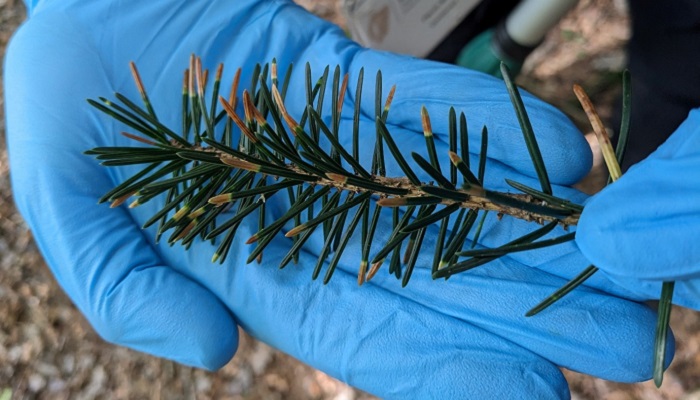[ad_1]
08 September 2023
Teagasc Forestry Development Department
Jo Ruane and Niall Farrelly provide an overview of ADAPTForRes, a new research project coordinated by Teagasc, which is an all island research collaboration aimed at strategies to increase the resilience in Irish forests.
Endophytes are fungi which have co-evolved with plants and grow inside plant tissue without causing any negative consequences to the host. Endophytic fungi can be beneficial to plants and promote plant growth by producing phytohormones, which can promote root and shoot formation and/or facilitate better nutrient update. Such hormones can also have a protective effect by acting as biological control agents and increase the plants resilience to environmental stresses. This is achieved by the production of antimicrobial and antioxidant like compounds which act to provide the tree with a pest and pathogen like defence mechanism.
Specific species of fungal endophytes have been known to enhance the thermal and drought tolerance of the trees by increasing the rate of photosynthesis and water retention under water limited conditions. The capability for increasing stress tolerance is anticipated to play an important role in the management of plants that are used as crops, albeit for food or timber in the future. In addition, recent studies have demonstrated the role of endophytic fungi as a bio-inoculant to enhance protection against disease.
The presence and composition of endophytes in habitats can tell us a lot about the conditions of a crop on a given site. In their endophytic phase, they work to provide a mutually beneficial symbiotic relationship with the host plant without causing any negative consequences. However, endophytes can also exist as latent pathogens which may become active under certain environmental conditions. If we understand what type of endophytes exist, it may prove to be a useful early indication if there are potential disease causing endophytes present in an ecosystem before they become problematic.
Fungal endophytes as early warning system
Climate change will create uncertainties for how forest ecosystems will adapt and alter our strategy to manage and protect our forests. We must be vigilant to limit the introduction of novel invasive fungal pathogens and have strategies to limit the spread and effect of existing diseases. It is uncertain whether warmer conditions associated with climate change will increase the prevalence of certain pathogens by providing conditions which will allow them to proliferate. Early warning systems such as monitoring are good strategies to detect diseases early on, before they become fully established, thus there is a greater chance of attaining a successful outcome for their control.
ADAPTForRes, a new research project coordinated by Teagasc, is an all island research collaboration aimed at strategies to increase the resilience in Irish forests. Changing climate conditions in some cases may result in a positive outcome for forests, by promoting increased growth (e.g. longer growing season) or bring negative effect consequences depending on how well the tree species can adapt to changing conditions.
It is hoped AdaptForRes will increase knowledge on endophyte diversity in Irish forests, including pathogenic endophytes, of Irish trees. The project hopes to provide innovative ways for detecting endophytes in Irish Forests. The goal is to explore ways of improving on the early warning systems that we have in place.
ADAPTForRes – Sampling Endophytic fungi
Flavio Storino, who is a PhD student, based at University College Dublin, is conducting the study on endophytic fungi in Irish forests. The research will demonstrate a baseline for fungal foliar diversity in trees at specific locations throughout Ireland. This work essentially creates a template for the development of a future surveillance network, which will enable foresters to ascertain the presence of pathogens in particular areas.
This task involves determining fungal endophyte populations in leaf samples from three different tree species in Ireland, both native and non native. These are Sessile oak, Scot’s pine and Sitka spruce.
Figure 1: Flavio Storino sampling sessile oak leaves for endophyte analysis

How do we determine endophytic populations?
Leaf samples are collected and the endophytic fungi are then extracted from the leaves, grown in growth media, isolated and genetically identified. This could have potential as a novel way to detect the presence of disease causing fungi. Essentially, this work is a preliminary study to see if such methods are robust to utilise as part of a surveillance efforts for Irish forests.
Figure 2: Needle samples placed on growth media to promote endophyte growth

Once pure cultures of the fungi have been isolated, the DNA is extracted and segments are amplified by PCR testing (polymerase chain reaction). This is a technique for rapidly producing or amplifying millions to billions of copies of a specific segment of DNA.
Figure 3: Endophyte proliferation following incubation

A technique known as barcoding allows the isolates to be further studied. These DNA barcodes can be compared to a reference library to provide a precise identification. An existing database of reference material has been compiled through previous research studies for example, Gembank.
Evaluation of the diversity of fungi out using statistical analysis (incl. diversity indices-which is a way to give a numerical value to how diverse an ecological community is). Overall, this research is invaluable and provides the first study of the population genetics of forest endophyte on the island of Ireland.
This article is an overview of forest protection measures within the ADAPTForRes project. The project is funded by the Department of Agriculture, Food and the Marine. The authors would like to thank Flavio Storino for demonstrating the field and laboratory techniques involved in the study.
For more forestry related material. Visit the Teagasc Forestry Development Department webpage.
Our Organisation
Connect with us
[ad_2]
